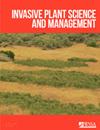Unraveling the influence of environmental factors on fireweed (Senecio madagascariensis) germination and its management implications
IF 1.2
4区 生物学
Q3 PLANT SCIENCES
引用次数: 0
Abstract
Fireweed (揭示环境因素对火烧草(Senecio madagascariensis)发芽的影响及其管理意义
火棘(Senecio madagascariensis Poir.)已经入侵并定居在澳大利亚东南部沿海地区的许多栖息地,是耕地以及草质差、疏于管理和放牧严重的牧场中的主要杂草。为了研究马达加斯加草(S. madagascariensis)两个种群(Felton 和 Gatton)的种子萌发生态学,我们在实验室和筛选室进行了实验。随着温度从最冷温度(15/5 C)到较高温度(25/15 C)的交替升高,两个种群的发芽率都有所提高。然而,最高温度(35/25 摄氏度)下的发芽率最低。与费尔顿种群相比,加顿种群对盐胁迫和水胁迫的耐受力更强。与交替光照和黑暗期(各 12 小时)(97-98%)相比,在完全黑暗(24 小时)条件下(33-39%),两个种群的发芽率都显著降低。筛房种子埋藏深度实验显示,两个种群的马达加斯加绣线菊出苗率相似。将种子置于土壤表面时,出苗率最高(60%),随后随着埋藏深度的增加,出苗率急剧下降。埋藏深度为 4 厘米的种子没有出苗。在土壤表层添加小麦作物残留物(添加量相当于 4 至 8 兆克公顷-1)后,马达加斯加草(S. madagascariensis)的出苗率显著下降。本研究获得的信息可用于管理和开发有效的杂草管理策略,以控制不同农业生态条件下的马达加斯加蓟马。
本文章由计算机程序翻译,如有差异,请以英文原文为准。
求助全文
约1分钟内获得全文
求助全文
来源期刊

Invasive Plant Science and Management
PLANT SCIENCES-
CiteScore
2.20
自引率
9.10%
发文量
24
审稿时长
6-12 weeks
期刊介绍:
Invasive Plant Science and Management (IPSM) is an online peer-reviewed journal focusing on fundamental and applied research on invasive plant biology, ecology, management, and restoration of invaded non-crop areas, and on other aspects relevant to invasive species, including educational activities and policy issues. Topics include the biology and ecology of invasive plants in rangeland, prairie, pasture, wildland, forestry, riparian, wetland, aquatic, recreational, rights-of-ways, and other non-crop (parks, preserves, natural areas) settings; genetics of invasive plants; social, ecological, and economic impacts of invasive plants and their management; design, efficacy, and integration of control tools; land restoration and rehabilitation; effects of management on soil, air, water, and wildlife; education, extension, and outreach methods and resources; technology and product reports; mapping and remote sensing, inventory and monitoring; technology transfer tools; case study reports; and regulatory issues.
 求助内容:
求助内容: 应助结果提醒方式:
应助结果提醒方式:


